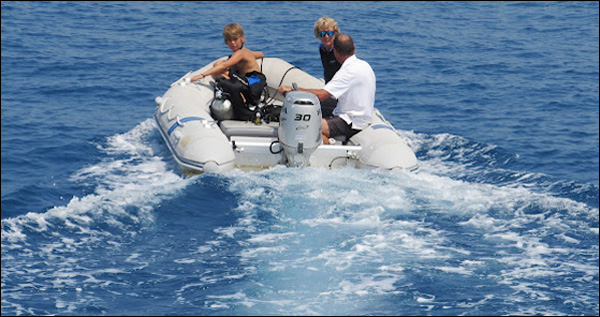
Once you’ve selected a dinghy that you believe will best serve your needs when cruising (see last month’s Admirals’ Angle), it’s time to start outfitting it so that it WILL serve those needs. Many sailors allow this to evolve, but some forethought can make a huge difference in how easy your dinghy will be to run, use, hoist aboard and launch.
The first thing you will shop for is an outboard.
You may be offered a package deal for one when you buy your dinghy. Proceed cautiously; just because it’s a deal, doesn’t always mean it’s a good deal for you.
- First, read the placard on the transom of the dinghy to determine what range of horsepower (hp) and weight the dinghy can handle, and understand that there’s an upper limit for safe operation.
- Next, zero in on what performance you expect. Will you mostly use it to putter around an anchorage, or do you expect to make long trips where you will need enough power to get you and any load (e.g. multiple people or scuba gear) up on a plane?
- Finally, as you weigh brand names, consider the ability to get service in remote destinations.
Just as there has been a trend in recent years toward bigger tenders, there has been a trend toward more horsepower.
Logical: it takes more oomph to move heavier dinghies. There is, however, also the factor of modern mankind’s addiction to speed, and speed in a dinghy is a lot more dangerous than people realize. In my sailing career I’ve known several people who’ve been run over by their own dinghies after being thrown out after hitting a wave at speed. Usually they were travelling solo in an overpowered setup without using the kill switch. It’s not a pretty way to go.
So when choosing horsepower, remember that half the point of cruising is to slow the pace of life down a notch.
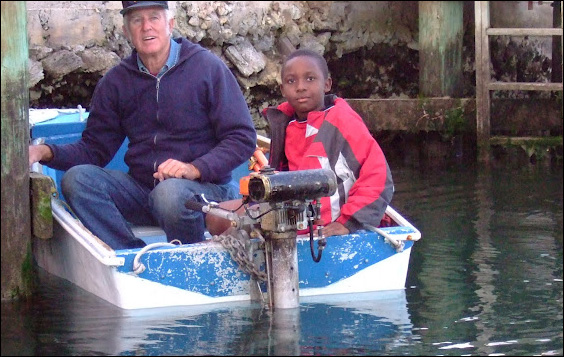
Also remember weight. Bigger outboards are heavier. Unless you have a catamaran or a very big monohull where you can carry your dinghy with the outboard in place, you will be manhandling your outboard and gas tank between the dinghy and the big boat every time you haul or launch your dinghy. In the store a bigger outboard may seem manageable, but picture yourself and your partner dancing around with it on deck in rolling or bumpy seas. We’ll talk later about ways to help manage this.
Finally, because big outboards can be harder for smaller women to pull-start and tilt up, they can cramp our independence. You don’t want an outboard you can’t use on your own!
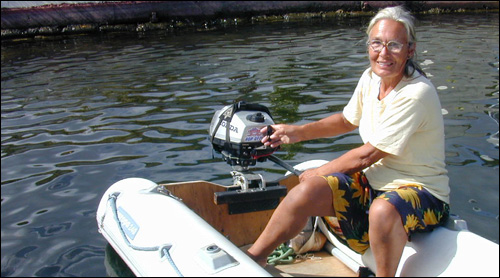
These days, in North America, your options in shopping new outboards are largely confined to four-stroke engines.
Four-stroke engines have pushed out two-stroke models because they are quieter, smoother, have better fuel economy, and meet stricter EPA pollution standards. I guess it’s the good-citizen choice.
However, if you already have a 2-stroke model, the reality of third world cruising is that you aren’t likely to encounter “4-Stroke-Only Waters.” Two-stroke engines have been in use all around the world for 80 years, which means in the smallest port you’ll likely find someone with knowledge and maybe even parts to fix it when there’s a problem, perhaps not as likely with a 4-stroke. For these reasons, some cruisers actually weigh the advantages of buying used two-stroke engines or waiting to buy new models outside the country where often prices are lower.
Many cruisers carry two outboards: a larger model – 10-20hp (with 15hp being average) – to use when taking bigger dinghies farther distances or carrying more load, and a small 2-3HP back-up motor that’s easy to hand up and down between deck and dinghy and which can certainly get you around most harbors while using much less fuel.
To give you an idea of real situations, our dinghy was a 10’4” AB RIB with a 15hp Yamaha (2-stroke) that would plane satisfactorily with us and our scuba gear or a third person, but not with the scuba gear and a third person. On the other hand, when our previous Johnson was stolen, we borrowed friends’ back-up 3hp Honda and were astounded that it could actually move our heavy dinghy and gear to a dive site. It took a lot more time, of course!
Speaking of theft, larger outboards are a very tempting item in many cruising grounds. Ours was stolen shortly after the Mexican government issued an edict that offshore fishermen must carry a spare motor!
- The first line of defense against theft is an outboard lock, a tube or channel designed to slide over your outboard’s mounting screws.
- Second is not to leave your dinghy floating overnight.
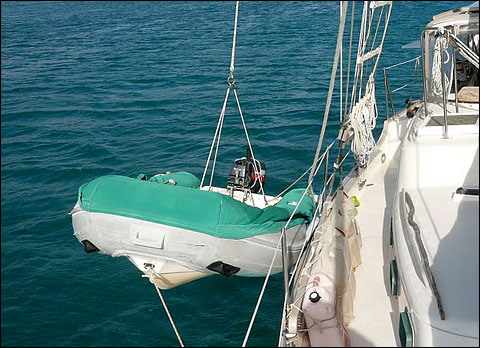 Instead, hoist it out of the water either on davits or alongside using your main halyard and a 3-point lifting harness (most inflatables come with eyes for this purpose and you can customize a harness from cable and Nicopress® fittings.)Raise it level with the deck against small fenders, secure the bow forward and stern aft so that it can’t shift around in wind or chop, and, in questionable areas, add a locking cable between the outboard and the mother ship. In addition to keeping your dinghy and outboard safe, this habit alleviates worries about careless knots or lines chafing through and keeps crud from growing on your dinghy’s bottom.
Instead, hoist it out of the water either on davits or alongside using your main halyard and a 3-point lifting harness (most inflatables come with eyes for this purpose and you can customize a harness from cable and Nicopress® fittings.)Raise it level with the deck against small fenders, secure the bow forward and stern aft so that it can’t shift around in wind or chop, and, in questionable areas, add a locking cable between the outboard and the mother ship. In addition to keeping your dinghy and outboard safe, this habit alleviates worries about careless knots or lines chafing through and keeps crud from growing on your dinghy’s bottom. - Another defense, less against theft than accident, is to have a short cable securing your mounted outboard to the one of the eyes on stern of the dinghy. Outboards put out a lot of torque and can spin themselves off the transom if bolts aren’t tightened enough.
Now that you have your new dinghy and outboard, you have to figure how best to carry them aboard for passages.
Before buying, hopefully you scrambled around with measuring tape to be sure the dinghy will fit on your foredeck or in your davits. Personally, I don’t favor davits, especially for long trips and heavier dinghies, except, of course, on catamarans. I don’t like the weight aft, the issue of shift and chafe in swell, the risk of getting pooped, and, not the least, the obstruction of my fishing deck and sightlines aft. We had davits but only used them in marinas.
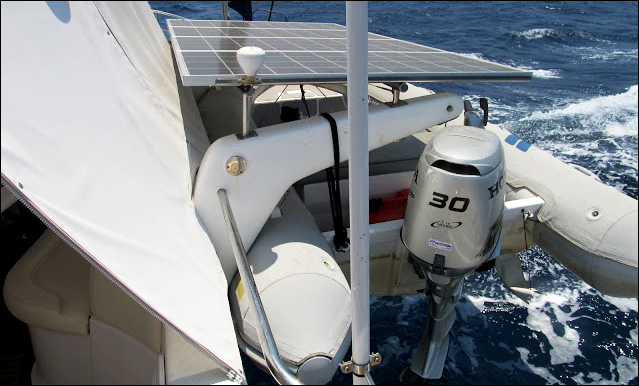
I (and I think the majority of monohull cruisers) prefer to hoist the dinghy aboard with a halyard and carry it upside-down on the foredeck. This keeps the underway boat a more compact unit, especially in heavy seas. If, however, it will interfere with getting around on deck, hopefully it’s not too late to consider an inflatable you can deflate and stow away instead of a rigid hull.
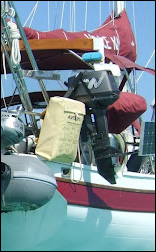 Underway, cruisers typically carry their outboard(s) on a special mount on the stern rail, arch or amidships by the mast, since most outboards ride best upright (with prop lower than the head). A mount on the stern makes it easy to integrate a small hoisting arm with block and tackle to facilitate manhandling the outboard between deck and dinghy.
Underway, cruisers typically carry their outboard(s) on a special mount on the stern rail, arch or amidships by the mast, since most outboards ride best upright (with prop lower than the head). A mount on the stern makes it easy to integrate a small hoisting arm with block and tackle to facilitate manhandling the outboard between deck and dinghy.
We positioned ours so that, with the dinghy secured bow and stern alongside the quarter, one of us could lift the engine from its mount and lower it – using a three-part tackle hitched to an outboard harness (ours was homemade from cable) – directly to the dinghy transom where the other would bolt it down. Never did we have to “dance” with our 15hp outboard and never was there a chance of dropping it overboard! Being prudent types, we still often hitched a safety line to the outboard handle.
Equipped with the right dinghy and outboard and a system for getting them aboard, the next step to the perfect cruising dinghy is to accessorize it so that it gives you the best service possible. More next month!
Photos: Thanks to Kathy Parsons, Hale Kai.
This article was published in the May 2012 issue of Latitudes and Attitudes.
Related articles on this website
- Choosing the Cruising Dinghy (Admiral’s Angle column #65)
- Accessorizing the Cruising Dinghy (Admiral’s Angle column #67)
- Dinghy Driving 101 (Admiral’s Angle column #11):Driving the dinghy is a real skill worth learning early to support confidence and avoid dependence.
- Ask your questions: Dinghy choice: RIB or hard dinghy?
